A thermal invisibility cloak that actively redirects heat
September 21, 2015

Active thermal cloak hides a circular object in conductive heat flow by “pumping” heat from hot end to cold end (credit: Xu & Zhang/NTU)
A new thermal cloak that can render an object thermally invisible by actively redirecting incident heat has been developed by scientists at the Nanyang Technological University (NTU) in Singapore. It’s similar to how optical invisibility cloaks can bend and diffract light to shield an object from sight and specially fabricated acoustic metamaterials can hide an object from sound waves.
The system has the potential to fine-tune temperature distribution and heat flow in electronic and semiconductor systems for applications that require efficient heat dissipation (cooling) and homogenous (even) thermal expansion, such as high-power engines, magnetic resonance imaging (MRI) instruments, thermal sensors, and clothing, said Prof. Baile Zhang of NTU.
Zhang and colleagues previously designed a metamaterial thermal cloak that passively guided conductive heat around a hidden object, with no way to control heat flow and direction. The researchers decided to look into controlling thermal cloaking electrically by actively “pumping” heat from one side of the hidden object to the other side, using thermoelectric modules, as described in an open-access paper and on the cover of Applied Physics Letters, from AIP Publishing.
Building the thermal cloak

Design of active thermal cloak. (a) Multiple thermoelectic components are arranged around the air hole with equal distance on the Carbon Steel plate. Blue components absorb incident thermal flux while red ones release heat back to the plate. (b) The side view of the marked region in (a), illustrating the working mechanism of TE components when functioning as heat absorber/emitter. An applied voltage causes a directional motion of charge carriers in positive/negative blocks, resulting in a heat flux in the designed direction. The bottom/top orange arrow indicates the absorption/release of heat by TE components. The dashed arrow indicates the heat transfer through a constant-temperature heat “reservoir” which is a large copper bulk in the experiment. (credit: Dang Minh Nguyen et al./Applied Physics Letters)
To construct their active thermal cloak, the researchers deployed 24 small thermoelectric modules, which are semiconductor heat pumps controlled by an external input voltage, around a 62-millimeter diameter air hole in a carbon steel plate just 5 mm thick. The modules operate via the Peltier effect, in which a current running through the junction between two conductors can remove or generate heat.
When many modules are attached in series, they can redirect heat flow. The researchers attached the bottom and top ends of the modules to hot and cold surfaces at 60° C and 0° C respectively to generate diffusive heat flux.
When the researchers applied a variety of specific voltages to each of the 24 modules, the heat falling on the hot-surface side of the air hole was absorbed and delivered to a constant-temperature copper heat reservoir attached to the modules. The modules on the cold-surface side released the same amount of heat from the reservoir into the steel plate. This prevented heat from diffusing through the air hole, a technique, the researchers say, that can be used to shield sensitive electronic components from heat dissipation.
The researchers found that their active thermal cloaking was not limited by the shape of the object being hidden.
Zhang and his colleagues plan to apply the thermal cloaks in electronic systems, improve the efficiency of heat transfer, and develop an intelligent control system for the cloak.
Abstract of Active thermal cloak
Thermal cloaking, as an ultimate thermal “illusion” phenomenon, is the result of advanced heat manipulation with thermal metamaterials—heat can be guided around a hidden object smoothly without disturbing the ambient thermal environment. However, all previous thermal metamaterial cloaks were passive devices, lacking the functionality of switching on/off and the flexibility of changing geometries. In this letter, we report an active thermal cloaking device that is controllable. Different from previous thermal cloaking approaches, this thermal cloak adopts active thermoelectric components to “pump” heat from one side to the other side of the hidden object, in a process controlled by input electric voltages. Our work not only incorporates active components in thermal cloaking but also provides controllable functionality in thermal metamaterials that can be used to construct more flexible thermal devices.